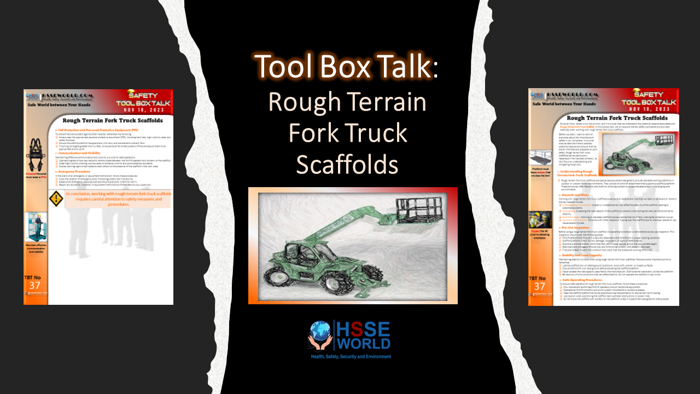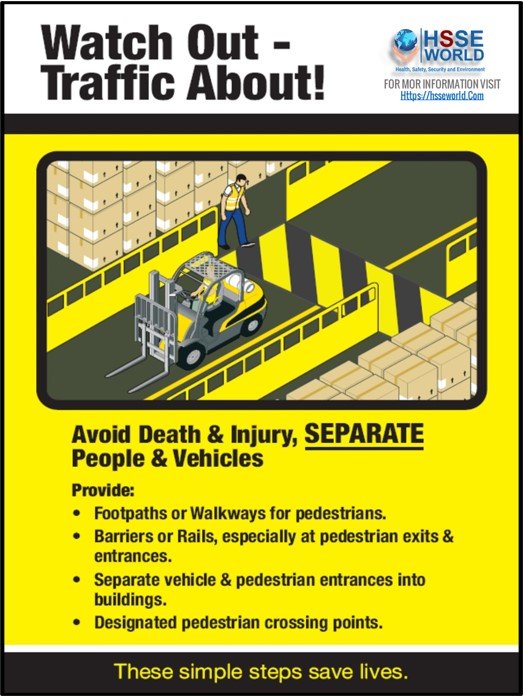Today, we will discuss an important topic regarding our work environment: Rough Terrain Fork Truck Scaffolds. As we all know, safety is our top priority, and we must understand the potential hazards associated with this equipment. This toolbox talk will explore the key safety considerations and best practices when working with rough terrain fork truck scaffolds. Let’s begin.
Read More: Powered Industrial Trucks

Opening
Before we start, I want to remind everyone about the importance of safety in our workplace. It’s crucial that we take the time to address potential hazards and ensure that we are all informed and prepared to work safely. Rough terrain fork truck scaffolds can be particularly hazardous if not handled correctly, so let’s focus on understanding and mitigating those risks.
1- Understanding Rough Terrain Fork Truck Scaffolds
Rough terrain fork truck scaffolds are specialized equipment designed to provide elevated working platforms in outdoor or uneven terrain environments. They consist of a forklift attachment that supports a scaffold platform. These structures offer flexibility and mobility, allowing workers to access elevated areas in challenging work environments.
Also Read: Mobile Crane: Basic Terms You Should Know
2-Hazards and Risks
Working with rough terrain fork truck scaffolds poses several hazards and risks that we must be aware of. Some of the key hazards include:
- Unstable ground conditions: Uneven or unstable terrain can affect the stability of the scaffold, leading to potential accidents.
- Overloading: Exceeding the load capacity of the scaffold or unevenly distributing the load can compromise its stability.
- Falls from height: Working on elevated platforms always carries the risk of falls, making fall protection crucial.
- Collisions and overturns: Collisions with other objects or tipping over the scaffold due to improper operation can cause severe injuries.
3-Pre-Use Inspection

Before using a rough terrain fork truck scaffold, it is essential to conduct a comprehensive pre-use inspection. This inspection should cover the following areas:
- Forklift attachment: Ensure it is securely attached to the forklift and in proper working condition.
- Scaffold platform: Check for any damage, loose parts, or signs of deterioration.
- Guardrails and toe boards: Verify that they are in place, secure, and at the appropriate height.
- Stabilizers and outriggers: Ensure they are functioning correctly and properly deployed.
- Tires and brakes: Inspect tire condition and check that the brakes are working effectively.
4-Stability and Load Capacity
Maintaining stability is crucial when using rough terrain fork truck scaffolds. Here are some important points to remember:
- Use the scaffold only on stable ground conditions. Avoid soft, uneven, or sloped surfaces.
- Ensure the forklift is on level ground before elevating the scaffold platform.
- Never exceed the load capacity specified by the manufacturer. Distribute the load evenly across the platform.
- Be cautious of wind conditions that can affect stability. Do not operate the scaffold in high winds.
5- Safe Operating Procedures
To ensure safe operation of rough terrain fork truck scaffolds, follow these procedures:
- Only trained and authorized forklift operators should handle the equipment.
- Operate the forklift smoothly and avoid sudden movements or excessive speeds.
- Keep the scaffold platform as low as possible during transportation to reduce the risk of tipping.
- Use caution when positioning the scaffold near overhead obstructions or power lines.
- Do not move the scaffold with workers on the platform unless it is specifically designed for that purpose.
6-Fall Protection and Personal Protective Equipment (PPE)
To prevent falls and protect against other hazards, remember the following:
- Always wear the appropriate personal protective equipment (PPE), including hard hats, high-visibility vests, and safety footwear.
- Ensure the scaffold platform has guardrails, mid-rails, and toe boards to prevent falls.
- If working at heights greater than six feet, utilize personal fall arrest systems (PFAS) and secure them to an appropriate anchor point.
Also Read: Personnel Hoisting Safety Guideline
7- Communication and Visibility
Maintaining effective communication and visibility is crucial for safe operations:
- Use hand signals or two-way radios to communicate between the forklift operator and workers on the scaffold.
- Wear high-visibility clothing, such as vests, to enhance visibility and avoid potential accidents.
- Display warning signs or barricades to alert others to the presence of the scaffold in the work area.
8-Emergency Procedures
In the event of an emergency or equipment malfunction, follow these procedures:
- Know the location of emergency exits, fire extinguishers, and first aid kits.
- Establish an emergency response plan and ensure everyone is familiar with it.
- Report any accidents, incidents, or equipment malfunctions immediately to your supervisor.
Also, Read: Emergency Response Planning for Hazardous Material
Conclusion
In conclusion, working with rough terrain fork truck scaffolds requires careful attention to safety measures and procedures. By understanding the hazards, conducting thorough inspections, following safe operating practices, and utilizing appropriate PPE, we can significantly reduce the risk of accidents and injuries. Remember, safety is a collective responsibility, and each one of us plays a vital role in maintaining a safe work environment. Thank you for your attention, and let’s prioritize safety in everything we do.
Also Read: Scaffolding Safety Tips


Download
Toolbox Talk: Rough Terrain Fork Truck Scaffolds
More Toolbox Talks
- Death of Oregon forestry worker prompts new toolbox talk
- Tool Box Talk: Securing a construction Site
- Tool Box Talk: Basic Electrical
- Tool Box Talk: Hazardous Chemicals- Four Routes of Entry
- Tool Box Talk: Excavation
- Tool Box Talk: Shift Work Dangers
- Tool Box Talk: Hearing Protection
- Tool Box Talk: Hydraulic Excavators: Lifting with Slings
- Tool Box Talk: Pneumatic tools
- Tool Box Talk: Oil Spill Response
- Tool Box Talk: Heart Risks: AEDs and CPR in the Workplace
- Tool Box Talk: Aerial Lift Safety
- Tool Box Talk: Aerogel Nanoporous Insulation Products
- Tool Box Talk: Arc Welding and Fire Safety
- Tool Box Talk: Asphalt Fumes: Roofing Operations
- Tool Box Talk: Biohazard Safety
- Tool Box Talk: Boom Truck Safety
- Tool Box Talk: Carbon Monoxide Poisoning
- Tool Box Talk: Rotary Hammers-Hammer Drills
- Tool Box Talk: Working Around Heavy Equipment
- Tool Box Talk: Winter Driving Safety Tips
- Tool Box Talk: Lockout and Tagging
- Tool Box Talk: Hand Grinder Safety
- Tool Box Talk: Don’t Let Chemicals Get to You
- Tool Box Talk: Rough Terrain Fork Truck Scaffolds




